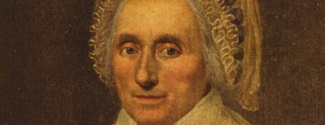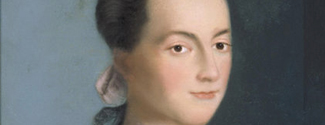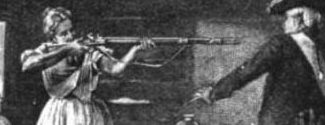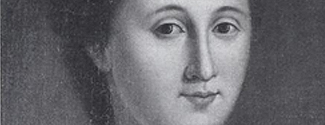“I desire you would remember the ladies”—March 31, 1776, Abigail Adams to her husband, John Adams
After reading the “Most Overrated Revolutionary” and the “Most Underrated Revolutionary,” and the amazing contributions by each and every person, it started me thinking about “the ladies” that I feel, in their own ways, helped achieve independence. The impact that ladies had on the revolutionary effort did not take center stage and has been underrated. The involvement of some of these women has not been as recognizable as others but they all had one thing in common, patriotic passion. These women were steadfast, dependable and assisted in every way imaginable, many even risking their own lives and fearing for their personal safety.
Even though society did not easily permit females to participate in the Revolutionary War, women did great things by giving to their country in many different ways. So their husbands did not have to manage homesteads, these ladies supported them by working farms, managing the Indians /Redcoats /frontier environment and caring for the sick so their families could stay together while their husbands were either fighting, creating or rallying the nation. These Patriots endured hardships only they could understand. John Adams wished to be a soldier, and expressed his desire that “every body must and will, and shall be a soldier”[1] but was much more successful in congress while his wife ran the farm. Many times women uprooted families to follow their husbands or left their children behind to be raised by friends and family, enduring the unwritten history of living life, the day in and day out hardships of survival. The women and children that followed endured the same living conditions and suffered the same privations as the soldiers in an army, which sometimes included a lack of food, clothing and shelter.[2]
The written history of the most underrated revolution was generally written by men, about men. Words are the only record that historians recognize. Even though these women were raising money through female-run organizations, refusing to buy British made products and even spying, too often the souls and passions of women went unrecorded. Their selfless actions allowed their men to take up arms and create a new nation.
Although there are too many women to list who contributed to the struggle for freedom and are not recognized, here are my ten picks listed in no particular order.
1. Mary Ball Washington
This is a woman that I personally feel has been forgotten. Granted, her only claim to fame is being George Washington’s mother and, at times, the relationship was known to be a little strained. But, Mary Ball Washington was widowed at the young age of thirty-five and left with five children to raise. George was eleven years old when his father died, allowing his mother’s demands to shape his character. Mrs. Washington was strong-willed and ruled her house with sternness and common sense and taught her son to be a man of honor and principle. It was this way of thinking which formed her son’s personality to lead by example. Although not much has been written about Mary, history has shown that she had a deep and profound influence on the life of the first President of the United States and, for this, Mary should be properly remembered.
2. Martha Custis Washington
Martha Custis Washington belongs to the club, which I like to call, “Ladies Who Are Not Well Known In Their Own Right” and is remembered more for whom she married. As the men were chanting at Valley Forge, “No bread, no soldier,” Martha Washington arrived on the scene with supplies from Mount Vernon. She set up a sewing circle of officers’ wives, including Kitty Greene and Lucy Knox, who both left their children at home and also joined their husbands. She traveled every year to winter quarters with her husband.[3] She emerged as a selfless, courageous and patriotic American. Mrs. Washington became indispensable as a comfort to Washington and his men. One witness to Martha’s activities later wrote: “I never in my life knew a woman so busy from early morning until late at night as was Lady Washington, providing comforts for the sick soldiers.”[4]

3. Lucy Flucker Knox
Lucy Flucker Knox was also known by the soldiers as Lady Knox. Although Lucy was, at times, thought to be aloof, she was kind and generous, never hesitating to share her and Henry’s food with starving men and showing compassion for the sick and injured. Lucy gave up her entire Loyalist family, never to see them again, to marry the man she had loved since she was just fourteen years old.
To support Henry when the Continental Army encamped at Valley Forge for the bitter winter, Lucy arrived along with their two-year-old daughter. General Knox and his wife were living in a structure he called a “hut” beside the artillery park, and along with Martha Washington and Kitty Greene, Lucy became a supportive and caring hostess to cold, ragged and hungry officers.
During the Revolution, most officers had homes for their wives to return to after following their husbands from camp to camp. Not Lucy and Henry Knox; they did not have a permanent home until they had been married for over 20 years. They gave numerous years to fighting for freedom and helping to create this new country.
What Lucy Knox gave should certainly be remembered.
4. Abigail Adams
Although John Adams could be “cranky and ill-tempered,” just think how grumpy he would have been without the support of his wife of fifty-four years, his “Portia.”[5]
In 1775, along with Mercy Warren and the governor’s wife, Hannah Winthrop, Abigail was appointed by the Massachusetts Colony General Court to question fellow Massachusetts women who were charged by either their word or action of remaining loyal to the British crown and working against the independence movement. John wrote to Abigail, “you are now a politician and now elected into important office, that of judges of Tory ladies.”[6]
As the Second Continental Congress was formed and debated the Declaration of Independence, Abigail began the argument in her letters to her husband that the creation of a new form of government was a chance to make the legal status of women equal to that of men.
Abigail remained in Braintree managing the farm and household and raising their children. Although women at that time did not normally handle business affairs, Abigail traded livestock, hired help, bought land, oversaw construction, and supervised the planting and harvesting, allowing her husband to become the statesman and leading advocate of American independence. “I hope in time to have the reputation of being as good a Farmess as my partner has of being a good Statesman,” she once wrote.[7]
Throughout his career, Abigail had served as unofficial advisor to John. Their letters show him seeking her counsel on many issues, including his presidential aspirations.[8]
Thankfully, their extensive correspondence has allowed us to know what an extraordinary woman Abigail Adams was.
5. Mercy Otis Warren
“America stands armed with resolution and virtue, but she still recoils at the idea of drawing the sword against the nation from whence she derived her origin.”—December 29, 1774, Mercy Otis Warren
Known as the “Conscience of the American Revolution,” Mercy Otis Warren accomplished things unknown to women in her time. She was a prolific and influential writer and the first woman playwright. She was a woman who spoke her opinions by writing them down. Her writings contained her beliefs, thoughts and opinions about wars and political issues and she sympathized with the call for revolution, composing political poetry.[9]
There are many women who definitely had a significant role in the formation of this country during the Revolution when formal politics did not include women. Early on, Mercy Otis Warren, while recognizing social differences between men and women, also knew that the minds of both genders could be equally valuable. To this end she realized that women needed education as much as men and pushed for schools to be established for women and girls. Although not a feminist in contemporary terms, she was unique in her time, writing and working for equal respect and equal rights for women, regardless of station in life.
6. Margaret Moore Barry
Known as the “Heroine of the Battle of Cowpens,” Margaret “Kate” Moore Barry volunteered as a scout for the American forces. Familiar with every trail and shortcut around her plantation in South Carolina and being an excellent horsewoman, Kate was crucial in warning the militia of the approaching British. The Battle of Cowpens took place on January 17, 1781. Before the battle, Kate was instrumental in rounding up militia, including her husband Captain Andrew Barry, to support General Daniel Morgan and his troops. Thanks to the bravery of women like Margaret Barry, the Battle of Cowpens was a decisive victory by Continental army forces in the Southern campaign of the American Revolutionary War.
7. Elizabeth Burgin
After the British army occupied New York City in 1776, residents who supported the rebellion kept a low profile. Many, however, continued efforts to support the American cause. Several thousand American prisoners of war were in their midst (the numbers changed constantly as prisoners were exchanged and others brought in); soldier prisoners were kept in the city, particularly at the Sugar House prison, sailors were put on board prison ships in the harbor, and officers were put on parole and quartered with residents of western Long Island. City resident Elizabeth Burgin helped these prisoners in various ways, but no explicit records survive of what sort of help she gave. Many modern writers say that she went on board the prison ships, but no sources support this, and she herself claimed to have helped army prisoners—who after 1776 were held on land, not on ships. What is clear is that her efforts put her in such danger that she was forced to escape from the city. After settling in Philadelphia, she petitioned Congress for support, but insisted on working for wages rather than taking the reward that Congress readily offered to her.
8. Nancy Hart
Here is a woman known to have a hot temper, fearless spirit and no hesitation to deliver revenge if she felt herself or any member of her family had been harmed.
The most well-known account of Nancy’s life begins when six British soldiers stopped at her cabin in search of a Whig leader, demanding information if he had stopped at her farm. Although the man they were tracking had been there, she denied seeing anyone.
Convinced that she was lying, one of the Tories shot and killed Hart’s prized gobbler, ordering her to cook the bird. Entering the cabin, they stacked their weapons in a corner and demanded something to drink. Hart obliged them by serving up wine. As the soldiers drank the wine, Hart sent her daughter to the spring for a bucket of water. She secretly instructed her daughter to blow a conch shell, kept in a nearby stump, to alert the neighbors that Tories were in the cabin.
As Hart served her unwelcome visitors and passed between them and their weapons, she began to pass the muskets through an opening in the cabin wall to her daughter, who had slipped outside to the rear of the house. When the soldiers noticed what was going on, they rushed to try and retrieve what weapons were left. She gave them one warning that she would shoot the next man that moved. Ignoring her warning, one man made the deadly mistake of approaching her. She held the rest off until her husband, Benjamin, and others arrived.
Benjamin Hart wanted to shoot the remaining hostages, but she insisted on hanging them.
In 1912 workmen grading a railroad near the site of the old Hart cabin unearthed a neat row of six skeletons that lay under nearly three feet of earth and were estimated to have been buried for at least a century.[10]
9. Esther DeBerdt Reed
Esther DeBerdt Reed was born in London, met American Joseph Reed, and they were married on May 31, 1770, eventually moving to Philadelphia.
As the Revolution progressed, Esther became disenchanted with her homeland and began to support the American cause. To show her patriotism, Esther established “The Ladies of Philadelphia.” The organization raised an enormous sum of $300,000 dollars for the troops by going door to door asking for donations.
“Esther suggested to General Washington” that the money be divided up and given to the soldiers. Although Washington was more than appreciative for the gift, he felt it would do more good if it was used for clothing. The women of The Ladies of Philadelphia bought linen, and sewed shirts for the American troops.
10. Margaret Cochran Corbin
Margaret Cochran Corbin was one of the wives who, during the Revolution, were tagged as “Camp Followers.” These women followed their husbands, cooking, washing laundry, and doing whatever domestic chores needed to be done.
On November 16, 1776, while they were stationed in Fort Washington, the fort was attacked by British and Hessian troops. Margaret’s husband, John, was assisting a gunner who was ultimately killed during the battle. John then took over as gunner until he was killed. Margaret, known as Captain Molly, had no time to mourn and continued firing the cannon alone until she was wounded, severely injuring her shoulder and chest and mangling her jaw. She never fully recovered from the wounds and was left without the use of her left arm for the rest of her life.[11]
EDITOR’S NOTE: This article originally published in 2013 included Sybil Ludington. She has been removed because, in spite of her fame, there is no direct evidence of her actions. In keeping with JAR’s mission of presenting only material supported by primary sources, we’ve added Elizabeth Burgin to this list of extraordinary women.
Be sure to read these JAR articles about other women in the American Revolution:
Henrietta Overing Bruce Auchmuty
[1] Edith B. Gelles, Abigail & John – Portrait of a Marriage (New York: Harper Collins, 2009), 57.
[2] Todd Andrlik, Reporting the Revolutionary War (Naperville, Illinois: Sourcebooks, Inc., 2012), 234.
[3] Joseph E. Fields, Worthy Partner – The Papers of Martha Washington (Connecticut: Greenwood Press, 1994), xxii.
[4] Cokie Roberts, Founding Mothers (New York: Harper Collins, 2004), 94.
[5] Edith B. Gelles, Abigail & John, 57.
[6] The National First Ladies Library, “First Lady Biography: Abigail Adams,” (accessed October 2, 2013, http://www.firstladies.org/biographies/firstladies.aspx?biography=2.
[7] Encyclopedia of World Biography, “Abigail Adams Biography,” accessed September 28, 2013 http://www.notablebiographies.com/A-An/Adams-Abigail.html.
[8] Bio – The True Story – A&E Network – 2013, “Abigail Adams Biography,” accessed October 2, 2013, http://www.biography.com/people/abigail-adams-9175670.
[9] Pamela Kline and Paul Pavao, “Mercy Otis Warren,” 2010-1013, accessed October 7, 2013, http://www.revolutionary-war.net/mercy-otis-warren.html.
[10] History and Archaeology, Revolution and Early Republic, 1775-1800, original entry by Clay Ouzts, Gainesville College, 8/12/2005, last modified 8/28/2013, ”Nancy Hart (ca. 1775-1830)” accessed September 27, 2013, http://www.georgiaencyclopedia.org/articles/history-archaeology/nancy-hart-ca-1735-1830
[11] Danuta Bois, “Distinguished Women of Past and Present – Margaret Chochran Corbin”, 1997, accessed October 8, 2013 http://www.distinguishedwomen.com/biographies/corbin.html.


















19 Comments
The impression I have of Mary Ball Washington, mainly from Chernow’s biography of George, was that Mary Washington wanted George to focus on her and not his, well, exploits. She seems to have been openly opposed to George’s politics and was described, contemporaneously, as a Loyalist. Her petition to the Governor of Virginia claiming to be destitute was very embarrassing to George. So yes, it does seem that she had a profound impact on George, but the impact was not a positive one. She seems to have been an influence that George reacted against instead reacting to.
Many of the ideas and opinions of the book you mention are questionable and some are known to be incorrect. Chernow relies heavily on old scholarship from other biographers rather than original sources and so has picked up the prejudices and beliefs of those other authors. Case in point, Chernow has young Washington going to the wilderness of the Ohio with Jacob Van Braam who according to the book had been Washington’s sword master (teacher) and a friend of his brother Lawrence. This is an error that dates all the way back to Washington Irving’s biography of Washington and has been repeated in countless other biographies since.
In short, don’t look to this book for your thoughts on Mary Ball.
For those interested in the topic, the inimitable Carol Berkin is giving the annual George Rogers Clark lecture to the Society of the Cincinnati today at 6:30pm EDT on the topic of Women in the Revolutionary Era. It is being streamed live at Fora.tv. Berkin is, of course, the author of both First Generations: Women in Colonial America and Revolutionary Mothers, the two best surveys of women’s history for the period. It will also be available to stream after the event is over, so it’s worth bookmarking the link.
The picture above linked to the name of Lucy Knox actually shows Margaret Arnold (a.k.a. Peggy Shippen), wife of Benedict Arnold. The two women are the subjects of a recent book by Nancy Rubin Stuart, Defiant Brides, but only one defiant bride, Arnold, made the cover. I’m not sure there is a reliable image of Lucy Knox; one portrait sometimes said to show her actually shows her daughter, Lucy Knox Fletcher.
Good eye. We’ve made the change and apologize for the error.
Great essay, Pamela. Thank you.
Thanks, also, to Michael for providing the link for Carol Berkin’s lecture.
Thank you, Suzanne. There are so many forgotten women who did such brave acts.
So glad you are writing about the women during the American Revolution!
There is nothing from the 18th century, however, that even hints that Martha Washington was “indispensable as a nurse” (or even WAS a nurse) to Washington’s soldiers. The quote from the “witness” to Martha’s activities refers to Valley Forge and was written by Benson J. Lossing over 100 years after the encampment. Lossing, Mary and Martha, p. 168-71.) Just how credible is this source?
Lucy Knox brought her daughter, age 2, to Valley Forge and arrived on May 27, 1778. They lived, not in a “large stone house,” but in General Knox’s “hut” near artillery park. (Henry Knox to William Knox, May 27, 1778) Again, there is nothing credible from the time that supports the notion that Lucy Knox gave “aid to the sick and injured” during the Revolutionary War. Both Martha Washington and Lucy Knox were “ladies” in a very class-conscious society, and did not associate with those of the “lower sort.”
Nancy K. Loane, author of Following the Drum: Women at the Valley Forge Encampment (Potomac Books, 2009).
Thank you for reading the article. The quote of Martha Washington being “indispensable as a nurse and comfort to Washington and his men” came from the introduction of “Worthy Partner – The Papers of Martha Washington”. The introduction was written by Ellen McCallister Clark and the papers were compiled by Joseph E. Fields. They did not acknowledge Lossing. I properly quoted Mr. Fields and Ms. McCallister Clark. I fully realize that both Mrs. Washington and Mrs. Knox were from a different class of society, but it does not mean they were indifferent to the sick and injured. Yes, Lucy Knox took their two year old daughter with her. From my conversations with the staff at Montpelier, the Knox home in Maine, I received information ranging from a large farmhouse to a large stone house. But, if Henry wrote to William calling it a “hut”, then I assume it was much smaller than a “large stone house”
As usual, Mrs. Murrow has written a wonderful, well-researched, and informative article! All of these women were brave beyond measure. They faced the same treason charges if caught and prosecuted for their actions as the male patriots did. I do not know if faced with similar circumstances, I would be able to confront with such bravery the fate they would encounter if the Revolution had failed.
I always thoroughly enjoy Mrs. Murrow’s articles and look forward to learning even more from them! Keep up the great work!
On your references, the page on Mercy Otis Warren was actually written by Pamela Kline and Paul Pavao, not Paula Kline. Both are friends of mine. 🙂
Thanks, Esther. The author names for the Mercy Otis Warren citation (No. 9) have been corrected. Good eye!
Thank you for a wonderful article. I am pleased to have three ladies referenced that I knew nothing about and now intend to look into.
It is unfortunate that you did not have the space to go into more detail regarding Abigail’s request for “consideration of the ladies”. But I have listed below a website that has many of John and Abigail’s letters including her original request, his response and then a third with her final WORDS on the matter.
My personal reaction when originally reading these three letters was to laugh out loud and say to myself “God Bless them both!”.
http://www.masshist.org/digital adams/browse/letters_1774_1777.php
View 3/31-4/5/1776, 4/14/1776 & 5/7-9/1776
How many women actually gave their lives in this war? Not necessarily heroes, just got killed fighting for example, or hiding spies, treason etc. Has this been left out of history?
The first person to come to mind in answering this question is agent 355 of the Culper Spy Ring. I have read many accounts of this group and remember one saying that she was captured and died on The Jersey. But that may be pure fabrication. I have often wondered if what might have happened to her was the reason Townsend backed off in his participation in the Ring for a period of time. Of course it may very well be that she survived the Revolution and went on to live a long life as well. Four of the Ring members were revealed with the discovery of the Townsend Papers in 1920 and Austin Roe was identified in 1950 but the lady remains a mystery……………most likely for all time.
Mary Bell Washington was widowed at the age of 35 to raise 5 children she taught her son George Washington how to become a man of honor.
Catherine Moore Barry was a women who volunteered as scout for the American army forces she also played a crucial rule informing the American troops of when the british were coming.
I believe Lydia Darragh should have been on the list.
First, I’m confused that the article is dated today but the comments are years old. Reprint?
Second, I enjoyed this article, but we’re a long way from exhausting the list of interesting women during this era. May I suggest a follow-up or two to add to the women already named in this article? I immediately thought of Phillis Wheatley or one of the other “Molly Pitcher” women in addition to Margaret Corbin. And don’t forget to include some of the women who supported the British and their German allies, or Native American women and others on the frontier. Women like Frederika Riedesel, Nonhelema, or Mad Anne Bailey have long fascinated me.
Editors: Thank you for keeping yourselves to high standards and continuing the editing process.
Luddington is one of those stories we all hope is true but know that until evidence is brought forth it must remain a legend.